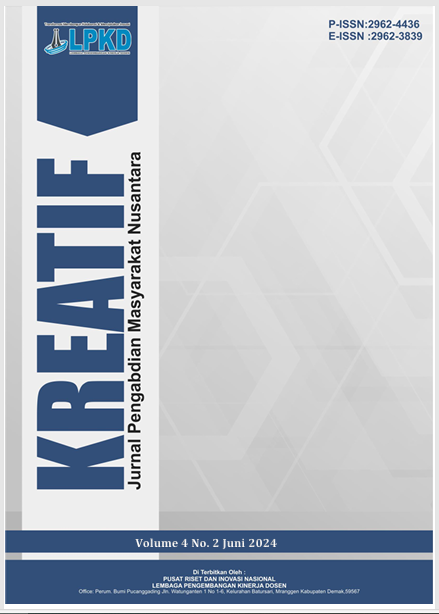Pengukuran Komposisi Tubuh dalam Upaya Deteksi Obesitas pada Laki-laki dan Perempuan Usia Produktif di SMA Kalam Kudus II, Kelurahan Duri Kosambi, Jakarta
DOI:
https://doi.org/10.55606/kreatif.v4i2.3359Keywords:
Body Composition Analysis, Diet, Nutrition, Intervention, Productive AgeAbstract
This community service evaluated body composition in men and women of productive age at Kalam Kudus II Senior High School, Duri Kosambi, Jakarta. This community service study included 68 respondents. Measurements were carried out using a body composition scae to assess percentage of total fat, visceral fat, subcutaneous fat and total muscle. The results showed that the 51-64 year age group had the highest percentage of total and visceral fat, while the 18-35 year age group had the highest percentage of total muscle. These findings emphasize the importance of routine body composition monitoring for early detection and appropriate intervention to prevent obesity and metabolic disease. Recommended interventions include a balanced diet, increased physical activity, and health education focused on weight management and healthy body composition. The use of body composition analysis technology can provide more accurate data to support effective and measurable health programs among the productive age group.
References
“Obesity and Overweight.” n.d. Accessed May 29, 2024. https://www.who.int/news-room/fact-sheets/detail/obesity-and-overweight.
Andreoli, Angela, Francesco Garaci, Francesco Pio Cafarelli, and Giuseppe Guglielmi. 2016. “Body Composition in Clinical Practice.” European Journal of Radiology 85, no. 8 (August): 1461–68. https://doi.org/10.1016/J.EJRAD.2016.02.005.
Bawadi, H., S. Hassan, A. Shanbeh Zadeh, H. Sarv, A. Kerkadi, Josep A. Tur, and Z. Shi. 2020. “Age and Gender Specific Cut-off Points for Body Fat Parameters among Adults in Qatar.” Nutrition Journal 19, no. 1 (July): 1–5. https://doi.org/10.1186/S12937-020-00569-1/TABLES/2.
Coin, Alessandra, Giuseppe Sergi, Nadia Minicuci, Sandro Giannini, Elisa Barbiero, Enzo Manzato, Mario Pedrazzoni, et al. 2008. “Fat-Free Mass and Fat Mass Reference Values by Dual-Energy X-Ray Absorptiometry (DEXA) in a 20–80 Year-Old Italian Population.” Clinical Nutrition 27, no. 1: 87–94. https://doi.org/https://doi.org/10.1016/j.clnu.2007.10.008.
Destra, Edwin, and Yohanes Firmansyah. 2022. “Intervention Program in Effort to Reduce New Cases.” Jurnal Pengabdian Mandiri 1, no. 5: 677–82.
Deurenberg, P., M. Deurenberg-Yap, and S. Guricci. 2002. “Asians Are Different from Caucasians and from Each Other in Their Body Mass Index/Body Fat per Cent Relationship.” Obesity Reviews 3, no. 3 (August): 141–46. https://doi.org/10.1046/J.1467-789X.2002.00065.X.
Devang, Nayana, M. Nandini, Satish Rao, and Prabha Adhikari. 2016. “Mid Arm Circumference: An Alternate Anthropometric Index of Obesity in Type 2 Diabetes and Metabolic Syndrome.” British Journal of Medicine and Medical Research 12, no. 1 (January): 1–8. https://doi.org/10.9734/BJMMR/2016/22263.
Gavriilidou, N N, M Pihlsgård, and S Elmståhl. 2015. “Anthropometric Reference Data for Elderly Swedes and Its Disease-Related Pattern.” European Journal of Clinical Nutrition 69, no. 9 (September): 1066–75. https://doi.org/10.1038/ejcn.2015.73.
Gómez-García, Anel, Erika Nieto-Alcantar, Carlos Gómez-Alonso, Benigno Figueroa-Nuñez, and Cleto Álvarez-Aguilar. 2010. “Parámetros Antropométricos Como Predictores de Resistencia a La Insulina En Adultos Con Sobrepeso y Obesidad.” Atencion Primaria 42, no. 7 (July): 364–71. https://doi.org/10.1016/J.APRIM.2009.10.015.
Han, T. S., Y. Y. Al-Gindan, L. Govan, C. R. Hankey, and M. E.J. Lean. 2019. “Associations of BMI, Waist Circumference, Body Fat, and Skeletal Muscle with Type 2 Diabetes in Adults.” Acta Diabetologica. https://doi.org/10.1007/S00592-019-01328-3.
Lee, Seung Hoo, and Hyun Sik Gong. 2020. “Measurement and Interpretation of Handgrip Strength for Research on Sarcopenia and Osteoporosis.” Journal of Bone Metabolism 27, no. 2 (May): 85–96. https://doi.org/10.11005/jbm.2020.27.2.85.
Panuganti, Kiran K., Minhthao Nguyen, and Ravi K. Kshirsagar. 2023. “Obesity.” StatPearls, August (August). https://www.ncbi.nlm.nih.gov/books/NBK459357/.
Rasmussen, J., A. Andersen, A. B. Fisker, H. Ravn, M. Sodemann, A. Rodrigues, C. S. Benn, and P. Aaby. 2012. “Mid-Upper-Arm-Circumference and Mid-Upper-Arm Circumference z-Score: The Best Predictor of Mortality.” European Journal of Clinical Nutrition 66, no. 9 (September): 998–1003. https://doi.org/10.1038/EJCN.2012.95.
Sánchez-García, Sergio, Carmen García-Peña, María Ximena Duque-López, Teresa Juárez-Cedillo, Alma Rosa Cortés-Núñez, and Sandra Reyes-Beaman. 2007. “Anthropometric Measures and Nutritional Status in a Healthy Elderly Population.” BMC Public Health 7, no. 1 (December): 2. https://doi.org/10.1186/1471-2458-7-2.
Shah, Nirav R., and Eric R. Braverman. 2012. “Measuring Adiposity in Patients: The Utility of Body Mass Index (BMI), Percent Body Fat, and Leptin.” PLoS ONE 7, no. 4 (April). https://doi.org/10.1371/JOURNAL.PONE.0033308.
Tejera, Cristina, Cristina Porca, Gemma Rodriguez-Carnero, Paula Andújar, Felipe F. Casanueva, Diego Bellido, and Ana B. Crujeiras. 2022. “Reducing Metabolic Syndrome through a Group Educational Intervention Program in Adults with Obesity: IGOBE Program.” Nutrients 14, no. 5 (March): 1066. https://doi.org/10.3390/nu14051066.
Yang, Guang Ran, Ming Xia Yuan, Gang Wan, Xue Lian Zhang, Han Jing Fu, Shen Yuan Yuan, Liang Xiang Zhu, et al. 2021. “Neck Circumference and Waist Circumference Associated with Cardiovascular Events in Type 2 Diabetes (Beijing Community Diabetes Study 23).” Scientific Reports 11, no. 1 (December). https://doi.org/10.1038/S41598-021-88927-9.
Downloads
Published
How to Cite
Issue
Section
License
Copyright (c) 2024 Alexander Halim Santoso, Fiona Valencia Setiawan, Bryan Anna Wijaya, Edwin Destra

This work is licensed under a Creative Commons Attribution-ShareAlike 4.0 International License.








